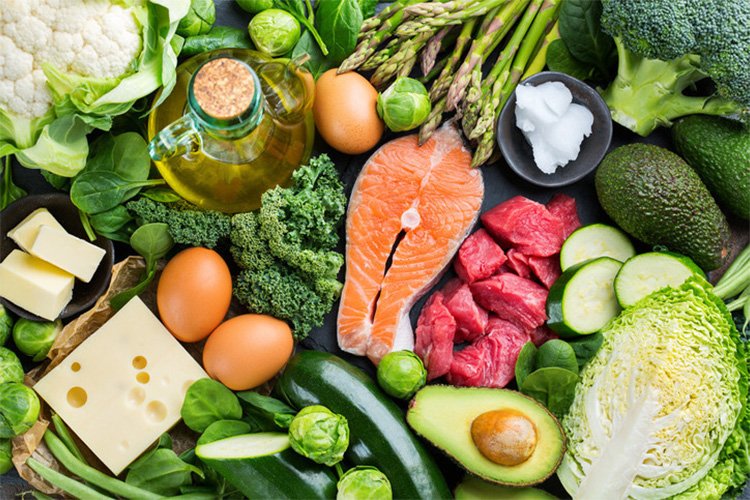
If you’re reading this, you’ve heard of the benefits of low-carb being touted all over social media to help with fat loss. But there are a number of options out there in terms of a diet approach, so where do you start? Atkins? Ketogenic? Carnivore? It may feel overwhelming with all these names, but they all are essentially trying to achieve the same thing…
Lower your insulin to discourage fat storage.
“Are you saying I need to lower my carbohydrates and increase my fat? I thought eating fat makes me fat?”
Any type of nutrient eaten in excess will get you fat. The same goes for carbohydrates. A good rule to go by to minimize fat storage further is to separate your higher fat meals with your carbohydrate meals to begin with:
The amount of carbohydrates determines how much insulin your body makes, insulin tells your body to stop burning fat[1]. So, if you’re eating a high amount of highly processed foods, your body will decide to store more fat. However, when you reduce your carbohydrate intake – switching your carbohydrate sources from highly processed foods to a sparse selection of seasonal fruits and vegetables – and increase your fat intake, the body can switch to burning fat as a primary source of fuel. This process is called ketosis, whereby the fats are turned into ketones by the liver that is then used as energy by the body[2].
Switching your primary fuel from carbs to fat take some time. In some cases, you may feel lethargic and have digestive issues, this is because your body is getting used to a different fuel source[3].
“Why would I want to go through all that just to burn fat?”.
The benefits of changing your fuel to fat are:
– Better body composition: Your body becomes a fat-burning furnace, the body burns off fat while preserving muscle leading to a better physique[4].
–Fewer cravings: High fat diet causes your body to make hormones that decrease your hunger levels[5]
–Improved Energy Levels: Initially you may feel fatigued as your body changes from using carbohydrates to burning fat. But being fat-adapted has been shown to improve energy levels, without the crashes that carbs gave give you[6].
–Lowers Blood Sugar: High-fat meals don’t cause insulin spikes, there is even a therapeutic effect for Type 2 diabetes[7].
–Improved Brain Function: The energy you get from fat can even improve planning and information processing[8], it could even protect the brain age related diseases[9].
Feel free to pan-fry your food, top it with butter or avocado, but be mindful of amounts as calories still matter. Remember, fat is your fuel now.
You must watch your Carbs as this will stop your body from using fat as fuel. Carbs should only make 5-10% of your total macros, this roughly translates to 20-50 grams of carbs a day, depending on your activity level[10].
While fruit may have great things like fiber and vitamins, they contain lots of sugars. One banana contains ~30 grams of carb which could spike your insulin and stop the fat burning process. Instead pan fry some eggplants or bell peppers, that way you get vitamins without sugar.
Ketchup, honey-mustard, BBQ sauce all lots of sugars in the form of high-fructose corn syrup not only can this knock you of fat burning. High-fructose corn syrup could even slow down your metabolism make you fatter[11] . Instead look for sugar free or paleo alternatives i.e., Primal Kitchen, Heinz stevia ketchup.
Stick to a natural sugar-free sweetener like Stevia. Monkfruit is a good sweetener too but just be sure you don’t go over your carb levels. Certain artificial sweeteners in diet sodas can increase inflammation[12].
Fatty fish like Salmon and Tuna contains Omega-3 fats which can help with heart, brain and immune health[13].
Bacon and eggs are a staple of low carb diets but try not to go too crazy on processed meats as they are a known carcinogen, so watch your daily intake. If you can get your hands on naturally smoked nitrate-free bacon even better. Services like Butcher-box and Piedmontese provide organic meats in bulk at a low cost.
Despite what your mom and pops may say new research shows eggs provide a high-quality protein while helping to prevent Type 2 diabetes, coronary heart disease and reduce appetite[14].
Carbs help with water retention, make sure you stay hydrated. Electrolyte powder can help with hydration and prevent cramps[15].
Having a good amount of protein in your diet will also help with cravings and allow you to put on muscle[16], try drinking a protein shake when you crave something sweet.
If you’re looking for a more customized approach with your fat loss goals and living a leaner, healthier life, get in touch to find out more about our online nutrition coaching and our one-on-one training, nutrition and lifestyle training options.
